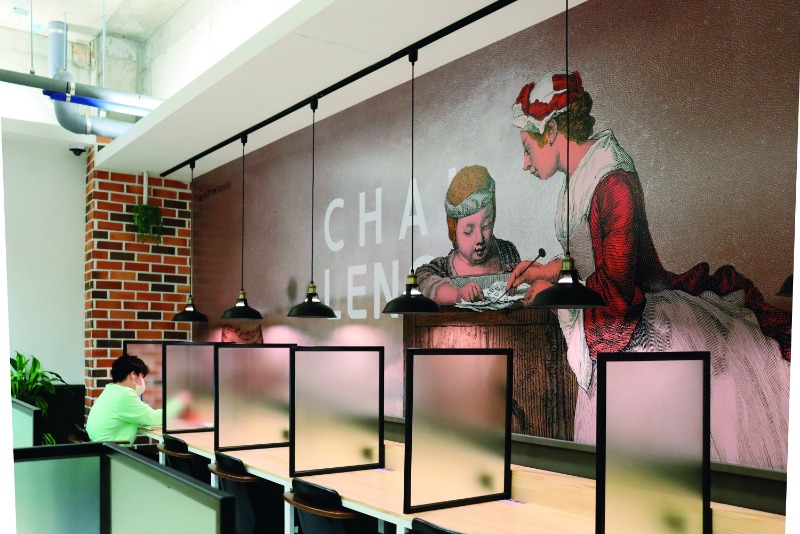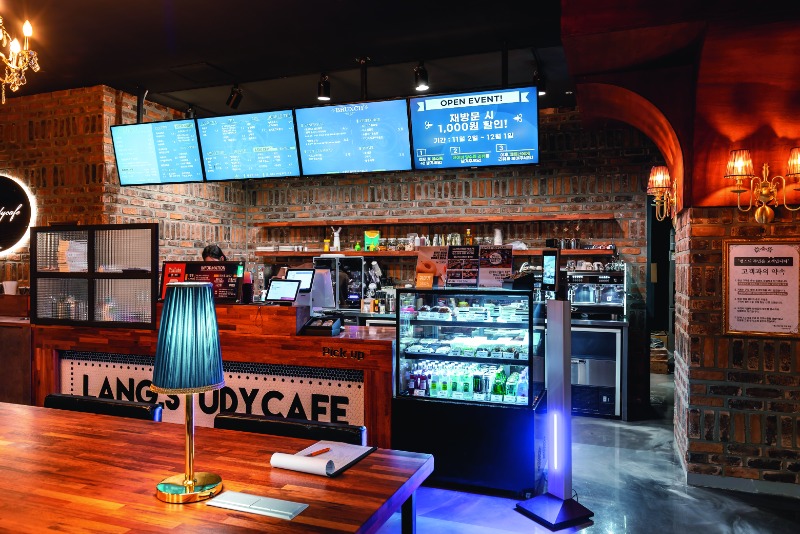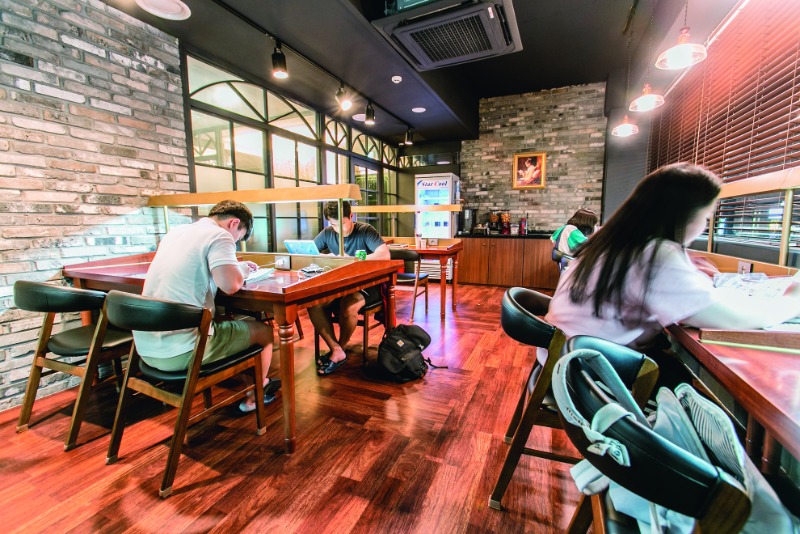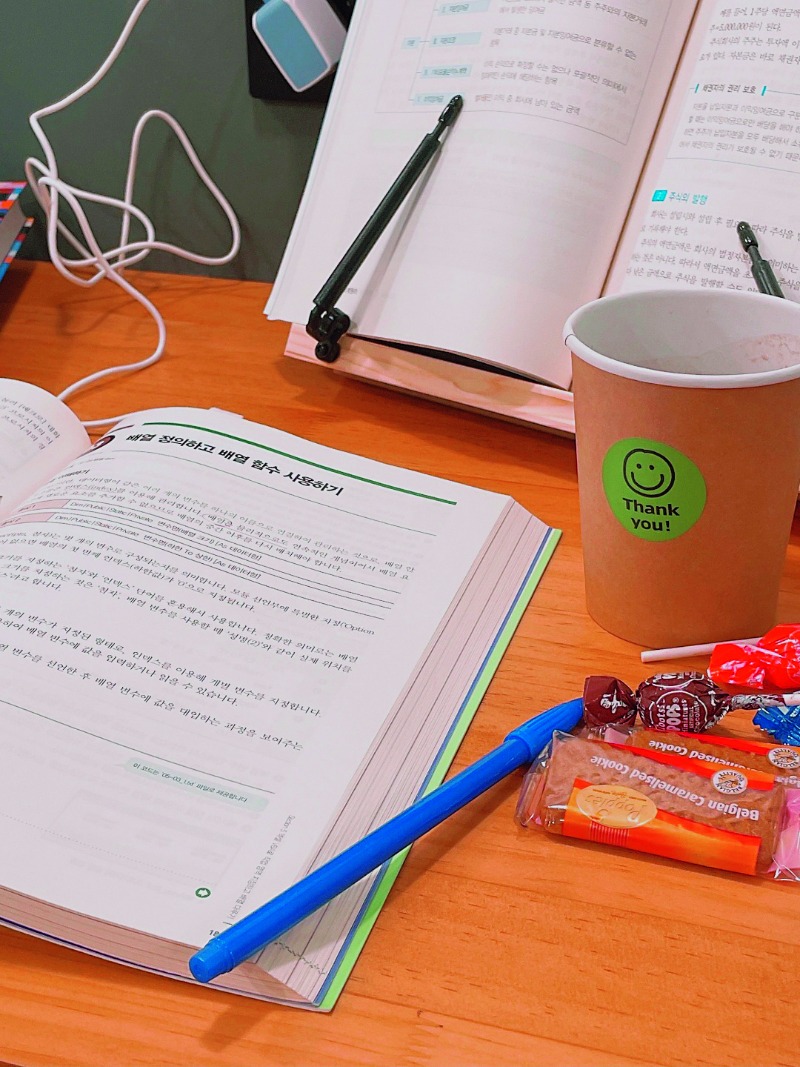Study cafés, a blend of conventional rented workspace and coffee shop, are in vogue among students, office workers and even the elderly.
Offering spaces for individuals and groups, they have grown increasingly popular amid the ongoing pandemic.

Study cafés started appearing in large cities about a decade ago and rose in number gradually. Then the COVID-19 pandemic triggered a dramatic increase as school and office shutdowns forced students and adults to find a safe place to work on individual and group assignments. Seats are typically separated by a translucent plexiglass barrier to create a workspace that feels less isolated.
© TRISYS
When COVID-19 shut down her university library, Park Jeong-eun headed for a study café, one of the few types of commercial spaces that has boomed during the pandemic. The café’s ambient noise seemed odd at first, but now the senior political science student at Inha University in Incheon is hooked on the environment.

Most study cafés have no staff working onsite and try to boost competitiveness by advertising special offers. Many of them provide good snack bar services. Some even develop snack bar menus each season for customers.
© THENEWWAYS
“I gradually adapted to the new surroundings, which provide a good environment for studying despite few movement restrictions,” said Park. “It’s become a favorite place of mine because I can concentrate better. Of course, I hope the pandemic will abate and I can use the school library again soon. But even then, I think I’ll come here again with my friends.”
Study cafés are a hybrid of a dokseosil (commercial study space) and a coffee shop. Most of them have no staff. Users buy a fixed amount of time at a kiosk and have their temperature checked by an automatic scanner before entering. They are free to sit anywhere and when their purchased time expires, the electricity at their workstation turns off. If you want more time, you simply top up at the kiosk.
Most floor plans have 50 to 100 seats. There are long tables with partitions as well as separate rooms, which are for online or face-to-face meetings, those clattering on laptops and notebooks or anyone seeking total isolation. Ambient noise, which, according to extensive research, improves concentration and task performance, is the main difference between study cafés and dokseosil. Natural sounds such as gently flowing water and soft breezes are played continuously through surround-sound speaker systems.
When study cafés first appeared about 10 years ago, most of the customers were high school students and young job seekers. But amid the pandemic, the shutdown of public and university libraries, a lack of quiet places to study and lockdown fatigue triggered continuous waves of college students and office workers.
DRASTIC INCREASE
The soaring rush quickly attracted the attention of corporate strategists and fledgling franchise owners, hence a stampede to open study cafés. They are now a new blue chip in the startup market. By February 2021, there were 40,824 study cafés across Korea, an 18 percent increase from 2020, with the buildup showing no signs of abating.
“The number of study cafés has increased dramatically since last year. They’re considered a good startup business idea as they need little labor and personnel costs and there’s constant demand for them,” said Yoon Hyung-joon, president of Trisys, an operator of franchise study cafés. He has about 100 cafés, a modest total compared to the 600 to 800 outlets owned by the biggest franchisers.
Kim Sin-ae opened a Trisys franchise in Goyang, Gyeonggi Province in February 2021. The pandemic was at its peak in Korea and she had the only study café in her neighborhood – until 10 or so more opened in the ensuing months.
“One study café opens each month. The market is saturated, but I think the craze will continue for the time being,” she predicted. “Even after the pandemic comes to an end, it’ll enjoy its high popularity. There’ll be a continuous supply of student customers, and study cafés will be still attractive to them. Under these circumstances, each shop will have to maintain its own competitiveness.”
Before the franchise, Kim spent 16 years running another type of space for students in Seoul: an after-school academy. A study café is less stressful because she doesn’t need to deal with many people, but there is more physical work to do, refilling the soda fountain and the coffee cart every morning and evening, along with diligent cleaning. Before a curfew was imposed for social distancing, her café never closed.
“Sales are way down now because we close at 10 p.m. But I achieved more sales from this business, when it was open 24/7, than from what I had earned from the cram school earlier. I think I made the right decision to change my line of business,” Kim said.
The COVID-19 pandemic isn’t the only factor propelling the popularity of study cafés. They also accommodate a dramatic shift in methods of teaching and learning. That shift should help maintain high usage even after the pandemic.
Traditionally, education in East Asia was based on rote memorization. During the Joseon Dynasty (1392-1910), young men preparing for civil service exams sequestered themselves in the back rooms of Buddhist temples in the mountains to memorize classical texts. A passing performance was the ticket to a successful public career and comfortable life.
In the postwar era, the university entrance exam became the new milestone event. Passing the exam promised social status and financial stability. Students spend their entire adolescence preparing for exam day, and anyone over 30 years old has likely used a neighborhood dokseosil and, of course, libraries during their high school days. But in some ways, these spaces can be too quiet. The sound of a door opening and closing or footsteps passing seem to reverberate to a distracting level.
The COVID-19 pandemic isn’t the only factor propelling the popularity of study cafés. They also accommodate a dramatic shift in methods of teaching and learning.
STUDY CULTURE
In the past decade or so, universities began to jettison midterm and final exams, which were essentially tests to see which students were best in recalling memorized facts and figures. Instead, they put greater stress on critical thinking to prepare students for jobs in Korea’s advanced economy. Projects and reports, often completed in groups, became more prominent in coursework. Today, students must prove their ability to identify and solve problems.
This means that simply memorizing facts and figures alone in a quiet place is no longer adequate. Now, students need a space to discuss and study together with their classmates. In a way, then, study cafés were the natural choice; they offer a more relaxed and harmonious atmosphere than a dokseosil or library, which eschew ambient noise, or a gosichon, a cluster of private dormitories where students and civil service examinees prepare for tests.
Not surprisingly, ordinary coffee shops have also seen a rise in customer traffic. Tired of working at home and holding video conferences, many office workers want a change of scenery and a chance to talk face to face. A new portmanteau buzzword, “coffice,” refers to a coffee shop that is like an office space, where workers meet over a cup of java.
Lee So-mi, a content designer, felt cramped working from home during lockdown. She used a coffee shop for several months, but it wasn’t easy or comfortable to occupy a table for long after ordering only a single cup of coffee. Furthermore, it was difficult to find a suitable shop on days when she had to participate in a video conference. To her, study cafés were like a new world. There, she was able to work without being disturbed and attend video conferences in a separate room. They were inexpensive and the pay-as-you-go system was a great boon to her because she was working irregular hours.

Users buy a fixed amount of time at a kiosk before entering. They are free to sit at an open table or in an individualized seating area with plexiglass shields. Most tables have an electrical outlet to power customers’ devices.
© INGStroy Inc.
FAVORITE DESTINATION
A coffee shop’s aim is to sell drinks and hope for a constant churn of table turnovers. One-cup customers who stay for several hours aren’t welcomed. Study cafés provide spaces that strike a balance between a coffee shop and dokseosil. In fact, they have become a favorite destination for people from a wide range of age groups, not just the younger generations.
“Of course, the majority of customers are students and office workers,” said Kim Sin-ae, the study café operator. “But there are elderly customers as well. It seems that people of a broad range of ages are using our shop to develop themselves or study to earn professional licenses or certificates. While running my study café, I’ve come to throw away my outdated notion that only young people study.”

Some study cafés develop their own menu to generate food sales. Some located near schools offer student customers free snacks and drinks.
© TRISYS